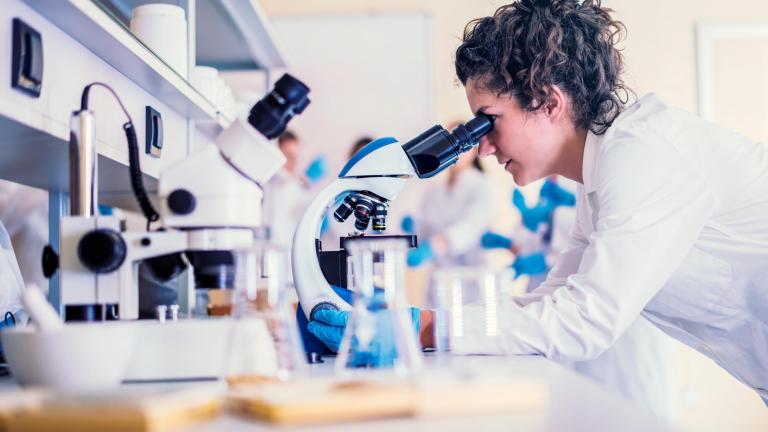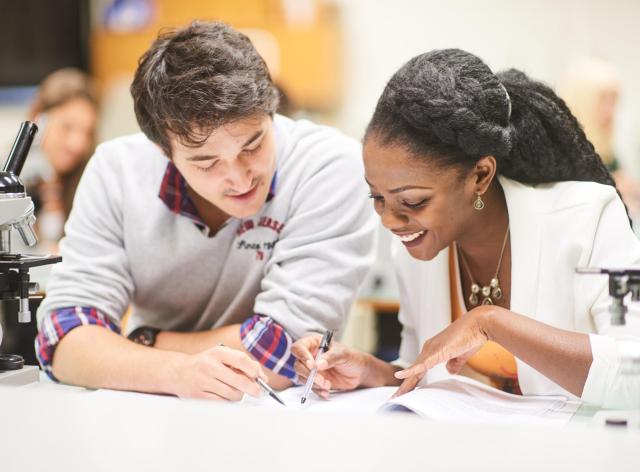Le Département de biologie veille à comprendre le monde vivant dans toute sa diversité, au cours de son évolution, des molécules aux écosystèmes, et répondre à des problèmes de société complexes comme la perte de biodiversité, les maladies infectieuses, la résistance aux antibiotiques, etc. Le biologiste utilise une approche intégrant le laboratoire, le terrain et l’outil informatique.
La biologie est une science moderne en plein mouvement. Elle répond à des problèmes de société complexes comme la perte de biodiversité, les résistances aux antibiotiques, l'adaptation aux changements climatiques, la lutte contre les maladies chroniques ou infectieuses, la sécurité alimentaire... Bref, la biologie est présente partout dans la société.
La biologie utilise une large palette de connaissances et d’approches scientifiques et technologiques qui lui permettent d’aborder le monde vivant dans sa diversité (virus, bactéries, champignons, plantes, parasites, animaux, humains), tout au long de son évolution et à tous les niveaux d’organisation (molécules, cellules, tissus, individus, super-organismes, populations, écosystèmes).
Des connaissances de processus fondamentaux aux multiples applications, le biologiste du 21e siècle est un scientifique complet, maniant la démarche scientifique, autant en laboratoire que lorsqu'il se rend sur le terrain (dans les espaces naturels) ou lorsqu'il utilise les méthodes d'analyse informatiques (et traite des données à haut débit).
Spotlight
News
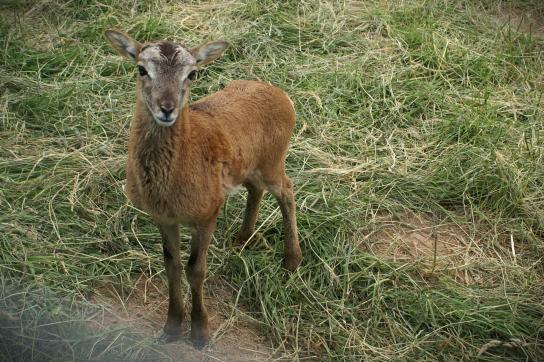
UNamur's Biology Department contributes its genetic expertise to saving a herd of mouflons
UNamur's Biology Department contributes its genetic expertise to saving a herd of mouflons
An unusual piece of research recently mobilized teams from UNamur's Biology Department. Genetic analyses carried out by the Environmental and Evolutionary Biology Research Unit (URBE) were able to confirm the protected status of a herd of wild mouflons based in Gesves, and thus highlight the importance of saving them.
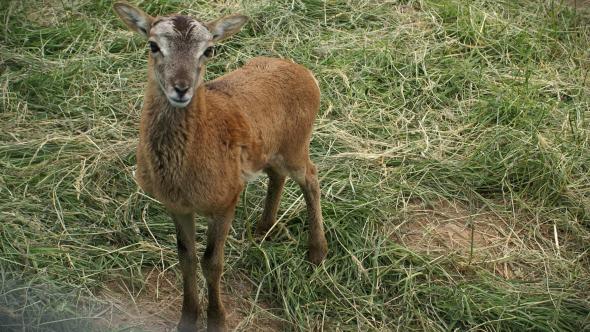
In recent months, the commune of Gesves, in the province of Namur, was confronted with the presence of a herd of mouflons, wild sheep recognizable by their impressive spiral horns. At the origin of this one: a male and a female probably escaped from a private hunt, who settled and reproduced in the meadows of this rural commune in 2019, until forming a full-fledged herd of 17 individuals in 2024.
While these sheep won the affection of the locals, local farmers deplored the damage caused to their crops. Their complaints led in August 2024 to a destruction authorization from the Department of Nature and Forestry (DNF). Several individuals were also shot during the hunting season.
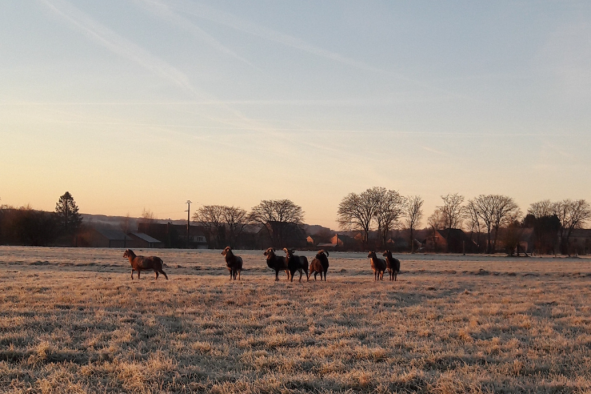
A complex rescue operation
Touched by the fate of these animals, a handful of local residents have been carrying out a veritable rescue operation for the seven mouflons still present on the meadows since January. The maneuver promised to be complex, to say the least: on the one hand, it was necessary to gather the official authorizations required to capture and transport the mouflons to a suitable location, and on the other hand, to set up an infrastructure to capture them.
.An enclosure equipped with a surveillance camera and an automated locking system was then installed by a specialist company. After months of patient, meticulous approach work, the mouflons were gently captured on May 24 and transferred to the Domaine des Grottes de Han, ready to welcome them.
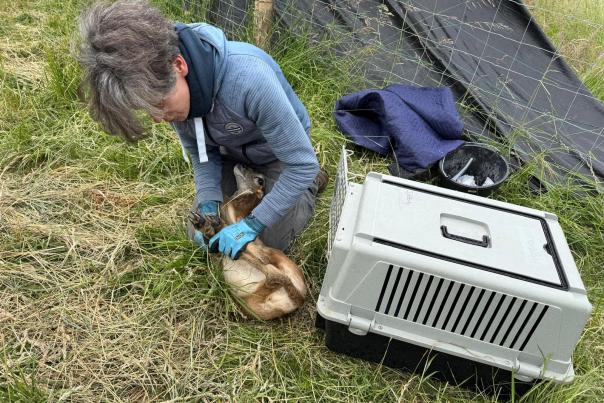
The origin of mouflons: DNA to the rescue
Alongside this initiative, the mobilized local residents - including Nathalie Kirschvink, a veterinarian and professor at UNamur's Faculty of Medicine - called on the expertise of the laboratories of UNamur's Environmental and Evolutionary Biology Research Unit (URBE) to clarify a crucial question: the origin of the mouflons. Indeed, in our regions, mouflons are considered game and therefore huntable, while mouflons from certain lineages benefit from protection.
Nathalie Kirschvink therefore entrusted fresh samples made up of hair and dung to Alice Dennis, professor and researcher at the URBE. Sequencing the DNA contained in these samples enabled Alice Dennis and technician Jérôme Lambert to identify kinship links between the Gesves bighorn sheep and those from a Corsican lineage, whose genome had already been described in the scientific literature.

This identification is based on phylogeny, a method used in the life sciences to reconstruct the evolutionary relationships between species by means of a phylogenetic tree, thus tracing their origins and family relationships.
From cell to ecosystem: delving into the infinitely small to protect living things
This expertise lies at the heart of URBE's research, which uses the tools of molecular ecology to study both the physiology of organisms (such as snails for Alice Dennis) and their interactions with their environment. The methodology used can be applied to very concrete, local cases, such as that of the Gesves bighorn sheep, but, more broadly, serve to better understand genetic diversity between species with a view to safeguarding biodiversity.
.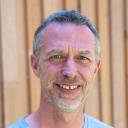
L'URBE is increasingly focusing on molecular ecology, a discipline that uses genetics to explore the capacity of species to adapt to environmental change. The more genetically diverse a population, the better its ability to adapt to environmental disturbances. These are essential questions in terms of species conservation, at a time when biodiversity is experiencing an unprecedented crisis.
Find out more about the Environmental and Evolutionary Biology Research Unit
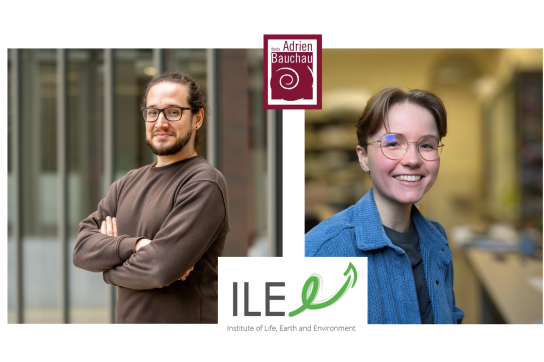
The Adrien Bauchau Fund rewards two researchers in biology
The Adrien Bauchau Fund rewards two researchers in biology
Professor Eli Thoré and Justine Bélik have just been honoured by the Adrien Bauchau Fund (FAB). Created in memory of the founder of the Biology Department at UNamur, the FAB has been promoting excellence in education and research in the life sciences since 1989.
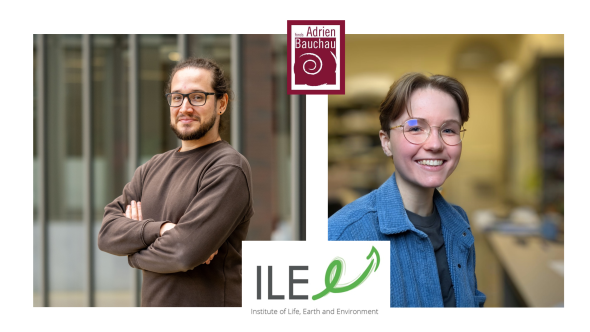
The FAB's regular actions in the Belgian university context include awarding grants, prizes and subsidies, organizing a chair, contributing to the organization of colloquia, doctoral schools or study days. It collaborates with a network of Belgian and foreign partners: individuals, public and private associations, institutions and companies.
Financial support for a young academic or post-doctoral fellow
In consultation with the Department of Biology at the University of Namur, the Fonds Adrien Bauchau has awarded financial assistance for the first time in the amount of 25,000 euros to support a young professor or post-doctoral fellow in biology at the institution in the early stages of their professional career.
In May 2025, the FAB Board of Directors awarded this grant to Professor Eli Thoré, an academic in the Unité de Recherche Environnementale et Evolutive (URBE), for the development of his work.
His work focuses on:
- "Investigating the individual and interactive effects of synthetic chemicals, artificial light, and increased temperature on the performance and wellbeing of fish"
- "Ecological impacts of pharmaceutical and light pollution in Belgium and Sweden’s waters"
- "Day-night impacts of drug mixtures on the threatened European eel"
Image caption: Eli Thoré and André Van den Bogaert, President of FAB.
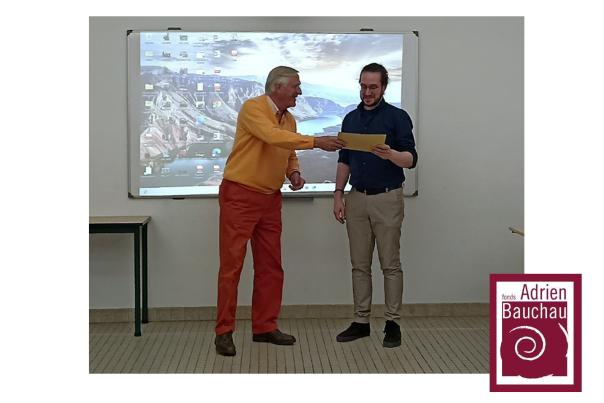
Bauchau grant Congress
The 2025 Scholarship has been awarded to Justine Bélik, whose thesis promoter is Professor Frédéric Silvestre, for her participation in the 3rd international EPIMAR 2025 "Epigenetics in marine and aquatic research" congress, organized at the end of May 2025 in Barcelona, Spain.
The grant is intended for a young researcher to enable his/her participation in a conference abroad. The amount awarded depends on the cost of this participation; it can be up to €750.
At a seminar organized by the ILEE Institute in June 2025, Justine Bélik also presented her ongoing research on epigenetic aging in Kryptolebias marmoratus, a vertebrate species characterized by self-fertilization.
Image caption: Justine Bélik, Séminaire ILEE
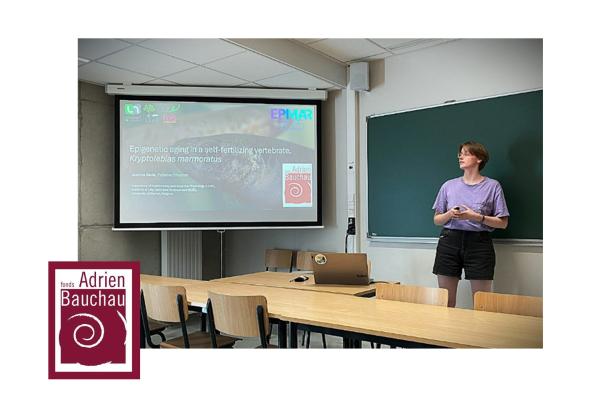
UNamur and biological research
The Biology Department conducts cutting-edge international scientific research. This is divided between 5 research units tackling a variety of themes: cell biology (URBC), microbiology (URBM) or methodology and didactics (UMDB). The two award-winning researchers are part of the Environmental and Evolutionary Biology Research Unit (URBE) and are members of the Institute of Life, Earth and Environment (ILEE), which is committed to addressing pressing environmental issues.
Professor Frédéric Silvestre, Justine Bélik's thesis sponsor, heads the Laboratory of Evolutionary and Adaptive Physiology (LEAP). This laboratory studies the impacts of environmental change on aquatic organisms at different levels, from the perspective of integrative physiology.
Professor Eli Thoré heads the Adaptive Biodynamics Laboratory (LAB). He uses an integrative approach to understand how animals respond to environmental changes, particularly those induced by human activity in space and time.
Biology studies at UNamur
The Department of Biology at UNamur offers you a cutting-edge scientific education that's modern, diversified and open to the world. From the cell to the ecosystem, biology studies all forms of life. It is essential for understanding complex societal issues affecting the environment, health and sustainable development.
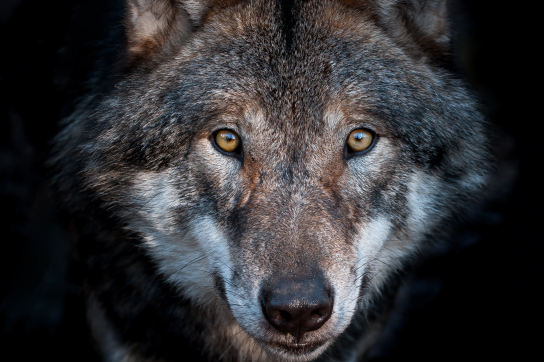
A first in Belgium: UNamur researcher reveals forgotten history of Walloon wolves thanks to ancient DNA
A first in Belgium: UNamur researcher reveals forgotten history of Walloon wolves thanks to ancient DNA
From 2020 to 2025, as part of her doctoral thesis in history, researcher Julie Duchêne conducted a ground-breaking investigation blending history and biology to trace the cohabitation between humans and wolves in Wallonia and Luxembourg, from the 18th to the early 20th century. Thanks to an innovative interdisciplinary approach, including DNA analysis of naturalized 19th-century specimens, her work sheds light on the mechanisms that led to the local extinction of the species. This research was made possible thanks to the support of numerous scientific and cultural partners.
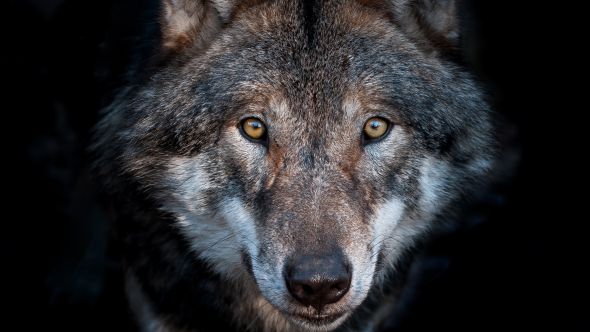
In her doctoral thesis, Julie Duchêne (PhD in History UNamur/FNRS-FRESH) has brought out of the shadows the unexplored history of the relationship between humans and wolves in the Walloon and Luxembourg territories during the pivotal period that saw the extinction of the species there (18th-early 20th century).
What's at stake in this research?
- To understand the complexity of this coexistence in our regions,
- To identify the influence of human activities on the lives of wolves and of wolves on human activities,
- To decipher the mechanisms that led to the extinction of Canis lupus.
To achieve this, the researcher has deployed a pioneering multidisciplinary methodology in Belgium, combining on the one hand historical and documentary analyses, and on the other morphological and DNA analyses of naturalized 19th-century wolves preserved within a dozen partner institutions, museums and venues in Wallonia. Thanks to collaboration between the E-BIOM laboratory and the University of Namur, 13 specimens were thus studied according to a rigorous protocol, respectful of the integrity of the historical pieces.
While ancient DNA is often degraded by time, conservation conditions or the products used during naturalization, 9 out of 13 samples yielded results.
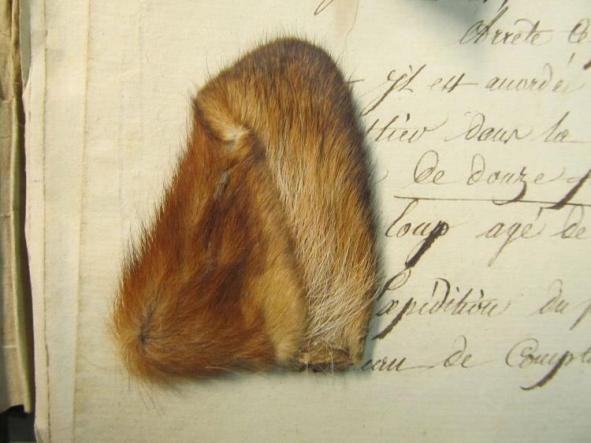
The main results of this analysis :
- Species confirmed : All the specimens analyzed belong to the species Canis lupus lupus, ruling out the hypothesis of dogs or hybrids.
- Kinship identified : Two wolves, including one kept by the de Bonhome family in Mozet, present a proven kinship.
- Dominant haplotypes: The majority of wolves belong to haplotypes H4 and H8, from a metapopulation historically present from western France to Germany.
- Discovery of an extinct haplotype: The Habay wolf, preserved by the de Beaulieu family, has a unique genetic profile, probably from a now-extinct population.
- Higher past genetic diversity: Wolves from the 18th and 19th centuries show greater genetic diversity than current populations.
- Wallonia, a historical crossroads: Even then, the region was at the crossroads of two major lupine dispersal routes: one from France, the other from Germany.

These discoveries underline the past genetic richness of wolves in Europe and the strategic position of Wallonia, already a crossroads for dispersal in the 19th century. A situation that echoes the territory's current recolonization by German-Polish and Italian-Alpine lineages
This study highlights the importance of heritage collections for better understanding the evolutionary history of species and contemporary conservation issues.
Want to find out more?
Discover all the results of this study and the "Loup qui es-tu?" project.
Brochure explaining the "Loup, qui es-tu?" project
To find out more ...
Deconstructing preconceived ideas about the wolf for a better-informed debate
The historical and scientific analysis carried out by Julie Duchêne also helps to qualify certain preconceived ideas about the wolf, often relayed in current debates.
- Attacks on human beings have existed, but they remain marginal and to be put into perspective. Complaints mainly concerned the loss of livestock (sheep, cows, horses, etc.).
- The wolf doesn't just live in the forest. Historically, it also frequented fields, roads, ponds and moors. Its presence depends on many factors, not a single habitat.
- The confrontations are not one-sided. They are also the result of human expansion into natural environments, not just wolf incursions.
- Populations did not seek to exterminate the species. They aimed for regulation, integrating lupine nuisances as well as other natural hazards.
- The wolf plays a positive ecological role, regulating populations of large herbivores, which promotes forest regeneration.
- The wolf's extinction is not due solely to eradication policies. It is the result of a combination of factors, including increasing human pressure on natural environments.
A study that extends into an exhibition
Julie Duchêne's research was also used to set up the exhibition "Même pas peur! Une évolution de l'image du loup à travers les siècles", developed by third-year history bachelor students as part of the Cultural Project course. The exhibition makes stops at :
- From May to early June 2025: Floreffe Seminary
- From June to September 2025: Pairi Daiza
- From October 2025 to May 2026: Gaumais Museum
About Julie Duchêne
Julie Duchêne holds a PhD in History from UNamur, specializing in environmental history and applied history (Public History). A FNRS-FRESH scholarship holder, she defended her doctoral thesis entitled "Les loups, de nuisibles à invisibles. Le rôle des politiques de lutte dans la disparition des loups des territoires wallon et luxembourgeois (18e-20e siècles), conducted under the supervision of Professor Isabelle Parmentier (director of the Pôle de l'histoire environnementale, institut ILEE).
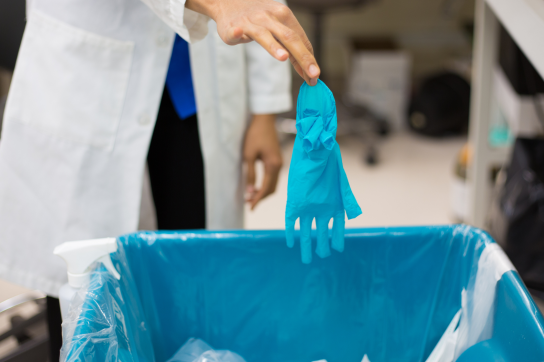
"Green Lab" initiative: towards more sustainable laboratories
"Green Lab" initiative: towards more sustainable laboratories
For several years now, researchers have been striving to make their laboratories "greener". A series of actions have been implemented, funded by the CaNDLE 2023 call for projects have been supported by the Department of Biology at the initiative of Alison Forrester and Frédéric Silvestre, the project leaders, as well as by Campus Infrastructure Management Services (SIGeC) and Prevention Services (SerP). In March 2025, a Green Day was held to provide information on the project's progress, and to motivate people to join the initiative.
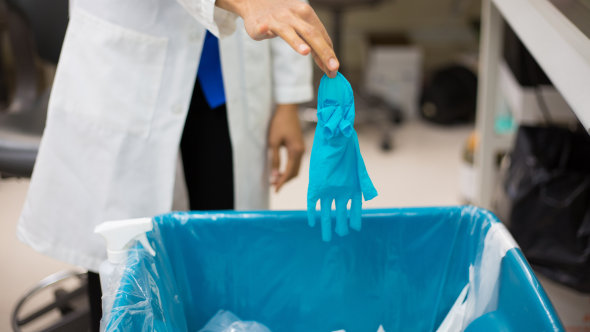
Since 2013, the aim of the Campus Namur Durable (CaNDLE) funding calls has been to invite the university community to propose actions aimed at making the campus and university activities more sustainable in the short, medium and long term.
The first and second CaNDLE calls contributed, in 2013 and 2015, to the realisation of eight projects likely to improve the sustainability of the campus or university activity. The 2021 call saw the launch of five new eco-responsible initiatives proposed by UNamur members and financed by the Jerome Fund for Sustainable Development, which included an award to the URVI, which headed by Benoit Muylkens, has been an excellent template for the initiative in the Department of Biology. In 2023, the CaNDLE call was financed thanks to the joint support of the « Jérôme fund for sustainable development » and the « Assembly of University of Namur Students Circles »
On 18 March 2025, researchers from the Department of Biology and Faculty of Medicine got together for a Green Day to raise awareness of the Green Lab initiative.
The aim is to reduce waste, increase recycling and reduce energy consumption, with a key focus on wet labs as well as throughout the university.
A working group made up of representatives from each unit, led by Alison Forrester and supported by Frederic Silvestre, has drawn up a list of actions aimed at making laboratory practices more sustainable. The Green Day provided an opportunity to present the many changes already implemented by the unit representatives, as well as the changes to come at laboratory and university level.

At the University of Namur, everyone knows everyone else, which means that initiatives of this kind can be implemented efficiently and logically. Our strength is the will and the motivation to change things. We have the support of the institution, which gives us the means to achieve our ambitions.
RRRR methodology - Reduce, Reuse, Recycle, Re-educate
Based on the saying that ‘the best waste is the waste that doesn't exist’, the project leaders looked at everything that could be made ‘greener’ in the context of the lab, using a precise ‘Reduce - Reuse - Recycle - Re-educate’ methodology, starting with the changes that can be made immediately, and then setting short-term (3-6 months), medium-term (6-12 months) and long-term (12 months and more) objectives.
The areas in which this methodology has already been applied include purchasing and use of laboratory supplies, energy consumption, waste management, infrastructure pooling, water consumption and filtration.
Staff training, new ways of working, the sharing of best practices and the pooling of infrastructures has produced very significant results. Specific examples are given at the end of this article.
Project sponsors
Alison Forrester
Alison Forrester is a qualified FNRS researcher. Her research group is based at the Unité de Recherche en Biologie Cellulaire (URBC) in the Department of Biology, where research is devoted to understanding cellular response mechanisms in normal and pathological situations. Alison Forrester is a researcher at the WEL Research Institute for the Welbio-Health program.
She is also Fellow NARC and member of the Institut Narilis.
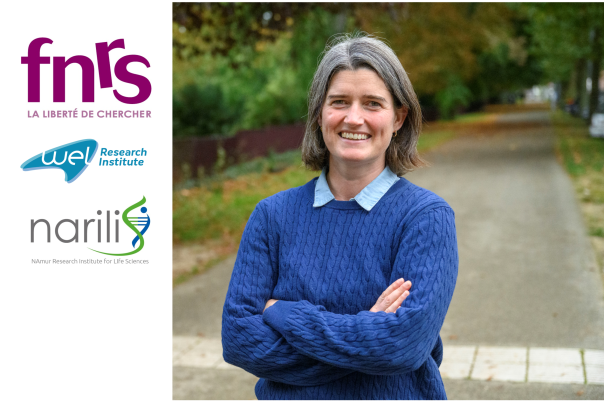
Fréderic Silvestre
Frédéric Silvestre heads the Laboratory of Evolution and Adaptive Physiology (LEAP). It is one of four laboratories belonging to the Environmental and Evolutionary Biology Research Unit (URBE) within the Biology Department. LEAP is also a member of the ILEE Research Institute.
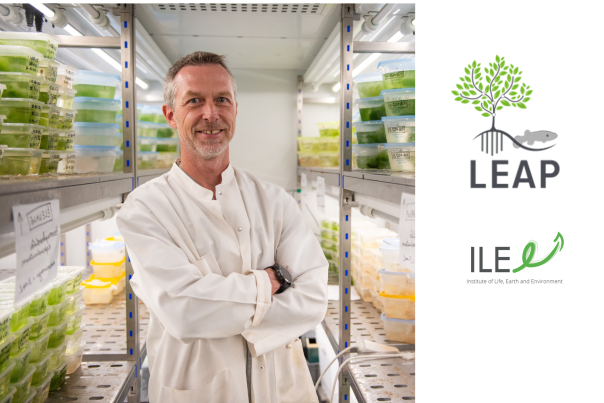
A key issue for the future
At the Green Day, external guest speaker Kristine Oevel, a former member of the first certified Green laboratory at the Leibniz-Forschungsinstitut für Molekulare Pharmakologie (FMP) in Berlin, gave a talk entitled ‘Obtaining green certification for FMP Berlin laboratories’. During her PhD at the FMP, Kristine was a key member of the team who initiated the move to sustainability, resulting in the laboratory obtaining certification from ‘My green lab’, for which the University of Namur also intends to apply.

Overall, the commitment of the people involved has been, and remains, enormous in terms of implementing and optimising sustainable practices and strategies. It's also very motivating when you see that the actions put in place are making huge savings in waste and also financially. All you need to do is change your habits. It takes energy and perseverance, but this initiative has been met with great enthusiasm from people across the university.
Starting from the Department of biology, we have been joined by Jean-Henri Rouard from « SiGEC » and Jean-Francois Pirlot from « SerP». Their involvement has been excellent, allowing us to efficiently increase the scope of the initiative, their progressive ideas have been perfectly complimentary to our perspective from teh side of the lab users. All of the laboratories in the Biology Department are already on board, and the Faculty of Medicine is joining the project. It's only just begun and already has great support. This is such an important element for the university,it's a key issue for the future.
This ‘Green Lab’ initiative, as well as the 1st ‘Green Day’ event, required both personal and collaborative efforts, and involved professors, researchers, doctoral students and students from the Biology Department, as well as staff from the Campus Infrastructure Management Service (SIGeC) and the Prevention Service (SerP): a convincing demonstration of the university community's high level of commitment to a more sustainable future.
Sustainable development at UNamur
The university has a duty to set an example in terms of sustainable development, to be ‘sustainable in form’ and ‘sustainable in substance’ in line with the United Nations' Sustainable Development Goals (SDGs).
RRRR methodology - Reduce, Reuse, Recycle, Re-educate - Some examples
Reduce (when possible)
Instead of buying products off the shelf, units are moving to using cell culture media made in-house. This reduces the cost from €9.50 to €2 per bottle. The same goes for the sterile PBS used in cell culture, down from €5 to less than €0.5 a bottle. This operation can also reduce the consumption of plastic bottles by up to 1,300 units per year per unit. The reuse of cell culture flasks can also help to reduce the current usage of 15,000 units per year per unit.
Good Lab Practice is also spreading to Good Work Practice, encouraging each person to take more responsability for energy use in the buildings. For example, turning off the lights or the computer when leaving the office or lab, and turning off lab equipment when not in use. Based on analysis on the efficiency of ultra-cold storage carried out in leading certified Green Labs the freezers have been reduced from -80°C to -70°C and from -20°C to -17°C, and the fridges from +4 °C to +7 °C, resulting in an estimated substantial saving of 30% in energy consumption without affecting the preservation of the products and biological samples.
Reuse (when possible)
By switching from plastic to glass, it is estimated that 30,000 single use aspiration pipettes and a percentage of the 25,000 test tubes will be saved. A process has been put in place to manage the work involved in this new working method. Dirty lab wear have to be collected, washed, sterilised and then redistributed. At the same time, products such as sterile PBS also has to be prepared, autoclaved and redistributed. This involves tasks distributed between the members of each research unit, which is estimated at 2 hours of each persons time every 10 weeks.
Recycle
Promoting daily recycling practices holds an ever important role. However the recycling of lab products is more complex, and purchasing items made from recycled and recyclable materials contributes to sustainable lab practice. New waste disposal routes are also being developed to allow the decontamination of hazardous waste (biohazardous or chemical waste) with an aim to decrease the amount of hazardous waste produced. Additionally, new bins that contain less plastics and cost less to dispose of, are being rolled out through the university labs. Better sorted waste in appropriately sized containers reduces disposal costs. Similar changes have been put in place for different types of waste (cardboard, plastic, glass) to improve efficiency.
Re-educate
Many sustainable changes can be made just by deciding to regulate your own behaviour. These decisions are fast and easy, but people need ideas! However implementing other changes involves a change in mentality and a reorganisation of work to share the load fairly. The green day provided information and day to day tips that all researchers can use to work in a sustainable manner. A virtual workspace containing information on sustainability and recordings of the Green Day presentations has been created and is accessible to all members interested in the initiative. A suggestion box is also available.

UNamur's Biology Department contributes its genetic expertise to saving a herd of mouflons
UNamur's Biology Department contributes its genetic expertise to saving a herd of mouflons
An unusual piece of research recently mobilized teams from UNamur's Biology Department. Genetic analyses carried out by the Environmental and Evolutionary Biology Research Unit (URBE) were able to confirm the protected status of a herd of wild mouflons based in Gesves, and thus highlight the importance of saving them.

In recent months, the commune of Gesves, in the province of Namur, was confronted with the presence of a herd of mouflons, wild sheep recognizable by their impressive spiral horns. At the origin of this one: a male and a female probably escaped from a private hunt, who settled and reproduced in the meadows of this rural commune in 2019, until forming a full-fledged herd of 17 individuals in 2024.
While these sheep won the affection of the locals, local farmers deplored the damage caused to their crops. Their complaints led in August 2024 to a destruction authorization from the Department of Nature and Forestry (DNF). Several individuals were also shot during the hunting season.

A complex rescue operation
Touched by the fate of these animals, a handful of local residents have been carrying out a veritable rescue operation for the seven mouflons still present on the meadows since January. The maneuver promised to be complex, to say the least: on the one hand, it was necessary to gather the official authorizations required to capture and transport the mouflons to a suitable location, and on the other hand, to set up an infrastructure to capture them.
.An enclosure equipped with a surveillance camera and an automated locking system was then installed by a specialist company. After months of patient, meticulous approach work, the mouflons were gently captured on May 24 and transferred to the Domaine des Grottes de Han, ready to welcome them.

The origin of mouflons: DNA to the rescue
Alongside this initiative, the mobilized local residents - including Nathalie Kirschvink, a veterinarian and professor at UNamur's Faculty of Medicine - called on the expertise of the laboratories of UNamur's Environmental and Evolutionary Biology Research Unit (URBE) to clarify a crucial question: the origin of the mouflons. Indeed, in our regions, mouflons are considered game and therefore huntable, while mouflons from certain lineages benefit from protection.
Nathalie Kirschvink therefore entrusted fresh samples made up of hair and dung to Alice Dennis, professor and researcher at the URBE. Sequencing the DNA contained in these samples enabled Alice Dennis and technician Jérôme Lambert to identify kinship links between the Gesves bighorn sheep and those from a Corsican lineage, whose genome had already been described in the scientific literature.

This identification is based on phylogeny, a method used in the life sciences to reconstruct the evolutionary relationships between species by means of a phylogenetic tree, thus tracing their origins and family relationships.
From cell to ecosystem: delving into the infinitely small to protect living things
This expertise lies at the heart of URBE's research, which uses the tools of molecular ecology to study both the physiology of organisms (such as snails for Alice Dennis) and their interactions with their environment. The methodology used can be applied to very concrete, local cases, such as that of the Gesves bighorn sheep, but, more broadly, serve to better understand genetic diversity between species with a view to safeguarding biodiversity.
.
L'URBE is increasingly focusing on molecular ecology, a discipline that uses genetics to explore the capacity of species to adapt to environmental change. The more genetically diverse a population, the better its ability to adapt to environmental disturbances. These are essential questions in terms of species conservation, at a time when biodiversity is experiencing an unprecedented crisis.
Find out more about the Environmental and Evolutionary Biology Research Unit

The Adrien Bauchau Fund rewards two researchers in biology
The Adrien Bauchau Fund rewards two researchers in biology
Professor Eli Thoré and Justine Bélik have just been honoured by the Adrien Bauchau Fund (FAB). Created in memory of the founder of the Biology Department at UNamur, the FAB has been promoting excellence in education and research in the life sciences since 1989.

The FAB's regular actions in the Belgian university context include awarding grants, prizes and subsidies, organizing a chair, contributing to the organization of colloquia, doctoral schools or study days. It collaborates with a network of Belgian and foreign partners: individuals, public and private associations, institutions and companies.
Financial support for a young academic or post-doctoral fellow
In consultation with the Department of Biology at the University of Namur, the Fonds Adrien Bauchau has awarded financial assistance for the first time in the amount of 25,000 euros to support a young professor or post-doctoral fellow in biology at the institution in the early stages of their professional career.
In May 2025, the FAB Board of Directors awarded this grant to Professor Eli Thoré, an academic in the Unité de Recherche Environnementale et Evolutive (URBE), for the development of his work.
His work focuses on:
- "Investigating the individual and interactive effects of synthetic chemicals, artificial light, and increased temperature on the performance and wellbeing of fish"
- "Ecological impacts of pharmaceutical and light pollution in Belgium and Sweden’s waters"
- "Day-night impacts of drug mixtures on the threatened European eel"
Image caption: Eli Thoré and André Van den Bogaert, President of FAB.

Bauchau grant Congress
The 2025 Scholarship has been awarded to Justine Bélik, whose thesis promoter is Professor Frédéric Silvestre, for her participation in the 3rd international EPIMAR 2025 "Epigenetics in marine and aquatic research" congress, organized at the end of May 2025 in Barcelona, Spain.
The grant is intended for a young researcher to enable his/her participation in a conference abroad. The amount awarded depends on the cost of this participation; it can be up to €750.
At a seminar organized by the ILEE Institute in June 2025, Justine Bélik also presented her ongoing research on epigenetic aging in Kryptolebias marmoratus, a vertebrate species characterized by self-fertilization.
Image caption: Justine Bélik, Séminaire ILEE

UNamur and biological research
The Biology Department conducts cutting-edge international scientific research. This is divided between 5 research units tackling a variety of themes: cell biology (URBC), microbiology (URBM) or methodology and didactics (UMDB). The two award-winning researchers are part of the Environmental and Evolutionary Biology Research Unit (URBE) and are members of the Institute of Life, Earth and Environment (ILEE), which is committed to addressing pressing environmental issues.
Professor Frédéric Silvestre, Justine Bélik's thesis sponsor, heads the Laboratory of Evolutionary and Adaptive Physiology (LEAP). This laboratory studies the impacts of environmental change on aquatic organisms at different levels, from the perspective of integrative physiology.
Professor Eli Thoré heads the Adaptive Biodynamics Laboratory (LAB). He uses an integrative approach to understand how animals respond to environmental changes, particularly those induced by human activity in space and time.
Biology studies at UNamur
The Department of Biology at UNamur offers you a cutting-edge scientific education that's modern, diversified and open to the world. From the cell to the ecosystem, biology studies all forms of life. It is essential for understanding complex societal issues affecting the environment, health and sustainable development.

A first in Belgium: UNamur researcher reveals forgotten history of Walloon wolves thanks to ancient DNA
A first in Belgium: UNamur researcher reveals forgotten history of Walloon wolves thanks to ancient DNA
From 2020 to 2025, as part of her doctoral thesis in history, researcher Julie Duchêne conducted a ground-breaking investigation blending history and biology to trace the cohabitation between humans and wolves in Wallonia and Luxembourg, from the 18th to the early 20th century. Thanks to an innovative interdisciplinary approach, including DNA analysis of naturalized 19th-century specimens, her work sheds light on the mechanisms that led to the local extinction of the species. This research was made possible thanks to the support of numerous scientific and cultural partners.

In her doctoral thesis, Julie Duchêne (PhD in History UNamur/FNRS-FRESH) has brought out of the shadows the unexplored history of the relationship between humans and wolves in the Walloon and Luxembourg territories during the pivotal period that saw the extinction of the species there (18th-early 20th century).
What's at stake in this research?
- To understand the complexity of this coexistence in our regions,
- To identify the influence of human activities on the lives of wolves and of wolves on human activities,
- To decipher the mechanisms that led to the extinction of Canis lupus.
To achieve this, the researcher has deployed a pioneering multidisciplinary methodology in Belgium, combining on the one hand historical and documentary analyses, and on the other morphological and DNA analyses of naturalized 19th-century wolves preserved within a dozen partner institutions, museums and venues in Wallonia. Thanks to collaboration between the E-BIOM laboratory and the University of Namur, 13 specimens were thus studied according to a rigorous protocol, respectful of the integrity of the historical pieces.
While ancient DNA is often degraded by time, conservation conditions or the products used during naturalization, 9 out of 13 samples yielded results.

The main results of this analysis :
- Species confirmed : All the specimens analyzed belong to the species Canis lupus lupus, ruling out the hypothesis of dogs or hybrids.
- Kinship identified : Two wolves, including one kept by the de Bonhome family in Mozet, present a proven kinship.
- Dominant haplotypes: The majority of wolves belong to haplotypes H4 and H8, from a metapopulation historically present from western France to Germany.
- Discovery of an extinct haplotype: The Habay wolf, preserved by the de Beaulieu family, has a unique genetic profile, probably from a now-extinct population.
- Higher past genetic diversity: Wolves from the 18th and 19th centuries show greater genetic diversity than current populations.
- Wallonia, a historical crossroads: Even then, the region was at the crossroads of two major lupine dispersal routes: one from France, the other from Germany.

These discoveries underline the past genetic richness of wolves in Europe and the strategic position of Wallonia, already a crossroads for dispersal in the 19th century. A situation that echoes the territory's current recolonization by German-Polish and Italian-Alpine lineages
This study highlights the importance of heritage collections for better understanding the evolutionary history of species and contemporary conservation issues.
Want to find out more?
Discover all the results of this study and the "Loup qui es-tu?" project.
Brochure explaining the "Loup, qui es-tu?" project
To find out more ...
Deconstructing preconceived ideas about the wolf for a better-informed debate
The historical and scientific analysis carried out by Julie Duchêne also helps to qualify certain preconceived ideas about the wolf, often relayed in current debates.
- Attacks on human beings have existed, but they remain marginal and to be put into perspective. Complaints mainly concerned the loss of livestock (sheep, cows, horses, etc.).
- The wolf doesn't just live in the forest. Historically, it also frequented fields, roads, ponds and moors. Its presence depends on many factors, not a single habitat.
- The confrontations are not one-sided. They are also the result of human expansion into natural environments, not just wolf incursions.
- Populations did not seek to exterminate the species. They aimed for regulation, integrating lupine nuisances as well as other natural hazards.
- The wolf plays a positive ecological role, regulating populations of large herbivores, which promotes forest regeneration.
- The wolf's extinction is not due solely to eradication policies. It is the result of a combination of factors, including increasing human pressure on natural environments.
A study that extends into an exhibition
Julie Duchêne's research was also used to set up the exhibition "Même pas peur! Une évolution de l'image du loup à travers les siècles", developed by third-year history bachelor students as part of the Cultural Project course. The exhibition makes stops at :
- From May to early June 2025: Floreffe Seminary
- From June to September 2025: Pairi Daiza
- From October 2025 to May 2026: Gaumais Museum
About Julie Duchêne
Julie Duchêne holds a PhD in History from UNamur, specializing in environmental history and applied history (Public History). A FNRS-FRESH scholarship holder, she defended her doctoral thesis entitled "Les loups, de nuisibles à invisibles. Le rôle des politiques de lutte dans la disparition des loups des territoires wallon et luxembourgeois (18e-20e siècles), conducted under the supervision of Professor Isabelle Parmentier (director of the Pôle de l'histoire environnementale, institut ILEE).

"Green Lab" initiative: towards more sustainable laboratories
"Green Lab" initiative: towards more sustainable laboratories
For several years now, researchers have been striving to make their laboratories "greener". A series of actions have been implemented, funded by the CaNDLE 2023 call for projects have been supported by the Department of Biology at the initiative of Alison Forrester and Frédéric Silvestre, the project leaders, as well as by Campus Infrastructure Management Services (SIGeC) and Prevention Services (SerP). In March 2025, a Green Day was held to provide information on the project's progress, and to motivate people to join the initiative.

Since 2013, the aim of the Campus Namur Durable (CaNDLE) funding calls has been to invite the university community to propose actions aimed at making the campus and university activities more sustainable in the short, medium and long term.
The first and second CaNDLE calls contributed, in 2013 and 2015, to the realisation of eight projects likely to improve the sustainability of the campus or university activity. The 2021 call saw the launch of five new eco-responsible initiatives proposed by UNamur members and financed by the Jerome Fund for Sustainable Development, which included an award to the URVI, which headed by Benoit Muylkens, has been an excellent template for the initiative in the Department of Biology. In 2023, the CaNDLE call was financed thanks to the joint support of the « Jérôme fund for sustainable development » and the « Assembly of University of Namur Students Circles »
On 18 March 2025, researchers from the Department of Biology and Faculty of Medicine got together for a Green Day to raise awareness of the Green Lab initiative.
The aim is to reduce waste, increase recycling and reduce energy consumption, with a key focus on wet labs as well as throughout the university.
A working group made up of representatives from each unit, led by Alison Forrester and supported by Frederic Silvestre, has drawn up a list of actions aimed at making laboratory practices more sustainable. The Green Day provided an opportunity to present the many changes already implemented by the unit representatives, as well as the changes to come at laboratory and university level.

At the University of Namur, everyone knows everyone else, which means that initiatives of this kind can be implemented efficiently and logically. Our strength is the will and the motivation to change things. We have the support of the institution, which gives us the means to achieve our ambitions.
RRRR methodology - Reduce, Reuse, Recycle, Re-educate
Based on the saying that ‘the best waste is the waste that doesn't exist’, the project leaders looked at everything that could be made ‘greener’ in the context of the lab, using a precise ‘Reduce - Reuse - Recycle - Re-educate’ methodology, starting with the changes that can be made immediately, and then setting short-term (3-6 months), medium-term (6-12 months) and long-term (12 months and more) objectives.
The areas in which this methodology has already been applied include purchasing and use of laboratory supplies, energy consumption, waste management, infrastructure pooling, water consumption and filtration.
Staff training, new ways of working, the sharing of best practices and the pooling of infrastructures has produced very significant results. Specific examples are given at the end of this article.
Project sponsors
Alison Forrester
Alison Forrester is a qualified FNRS researcher. Her research group is based at the Unité de Recherche en Biologie Cellulaire (URBC) in the Department of Biology, where research is devoted to understanding cellular response mechanisms in normal and pathological situations. Alison Forrester is a researcher at the WEL Research Institute for the Welbio-Health program.
She is also Fellow NARC and member of the Institut Narilis.

Fréderic Silvestre
Frédéric Silvestre heads the Laboratory of Evolution and Adaptive Physiology (LEAP). It is one of four laboratories belonging to the Environmental and Evolutionary Biology Research Unit (URBE) within the Biology Department. LEAP is also a member of the ILEE Research Institute.

A key issue for the future
At the Green Day, external guest speaker Kristine Oevel, a former member of the first certified Green laboratory at the Leibniz-Forschungsinstitut für Molekulare Pharmakologie (FMP) in Berlin, gave a talk entitled ‘Obtaining green certification for FMP Berlin laboratories’. During her PhD at the FMP, Kristine was a key member of the team who initiated the move to sustainability, resulting in the laboratory obtaining certification from ‘My green lab’, for which the University of Namur also intends to apply.

Overall, the commitment of the people involved has been, and remains, enormous in terms of implementing and optimising sustainable practices and strategies. It's also very motivating when you see that the actions put in place are making huge savings in waste and also financially. All you need to do is change your habits. It takes energy and perseverance, but this initiative has been met with great enthusiasm from people across the university.
Starting from the Department of biology, we have been joined by Jean-Henri Rouard from « SiGEC » and Jean-Francois Pirlot from « SerP». Their involvement has been excellent, allowing us to efficiently increase the scope of the initiative, their progressive ideas have been perfectly complimentary to our perspective from teh side of the lab users. All of the laboratories in the Biology Department are already on board, and the Faculty of Medicine is joining the project. It's only just begun and already has great support. This is such an important element for the university,it's a key issue for the future.
This ‘Green Lab’ initiative, as well as the 1st ‘Green Day’ event, required both personal and collaborative efforts, and involved professors, researchers, doctoral students and students from the Biology Department, as well as staff from the Campus Infrastructure Management Service (SIGeC) and the Prevention Service (SerP): a convincing demonstration of the university community's high level of commitment to a more sustainable future.
Sustainable development at UNamur
The university has a duty to set an example in terms of sustainable development, to be ‘sustainable in form’ and ‘sustainable in substance’ in line with the United Nations' Sustainable Development Goals (SDGs).
RRRR methodology - Reduce, Reuse, Recycle, Re-educate - Some examples
Reduce (when possible)
Instead of buying products off the shelf, units are moving to using cell culture media made in-house. This reduces the cost from €9.50 to €2 per bottle. The same goes for the sterile PBS used in cell culture, down from €5 to less than €0.5 a bottle. This operation can also reduce the consumption of plastic bottles by up to 1,300 units per year per unit. The reuse of cell culture flasks can also help to reduce the current usage of 15,000 units per year per unit.
Good Lab Practice is also spreading to Good Work Practice, encouraging each person to take more responsability for energy use in the buildings. For example, turning off the lights or the computer when leaving the office or lab, and turning off lab equipment when not in use. Based on analysis on the efficiency of ultra-cold storage carried out in leading certified Green Labs the freezers have been reduced from -80°C to -70°C and from -20°C to -17°C, and the fridges from +4 °C to +7 °C, resulting in an estimated substantial saving of 30% in energy consumption without affecting the preservation of the products and biological samples.
Reuse (when possible)
By switching from plastic to glass, it is estimated that 30,000 single use aspiration pipettes and a percentage of the 25,000 test tubes will be saved. A process has been put in place to manage the work involved in this new working method. Dirty lab wear have to be collected, washed, sterilised and then redistributed. At the same time, products such as sterile PBS also has to be prepared, autoclaved and redistributed. This involves tasks distributed between the members of each research unit, which is estimated at 2 hours of each persons time every 10 weeks.
Recycle
Promoting daily recycling practices holds an ever important role. However the recycling of lab products is more complex, and purchasing items made from recycled and recyclable materials contributes to sustainable lab practice. New waste disposal routes are also being developed to allow the decontamination of hazardous waste (biohazardous or chemical waste) with an aim to decrease the amount of hazardous waste produced. Additionally, new bins that contain less plastics and cost less to dispose of, are being rolled out through the university labs. Better sorted waste in appropriately sized containers reduces disposal costs. Similar changes have been put in place for different types of waste (cardboard, plastic, glass) to improve efficiency.
Re-educate
Many sustainable changes can be made just by deciding to regulate your own behaviour. These decisions are fast and easy, but people need ideas! However implementing other changes involves a change in mentality and a reorganisation of work to share the load fairly. The green day provided information and day to day tips that all researchers can use to work in a sustainable manner. A virtual workspace containing information on sustainability and recordings of the Green Day presentations has been created and is accessible to all members interested in the initiative. A suggestion box is also available.
